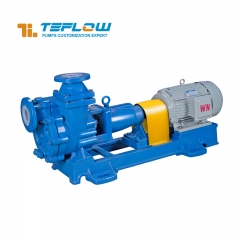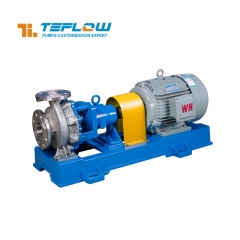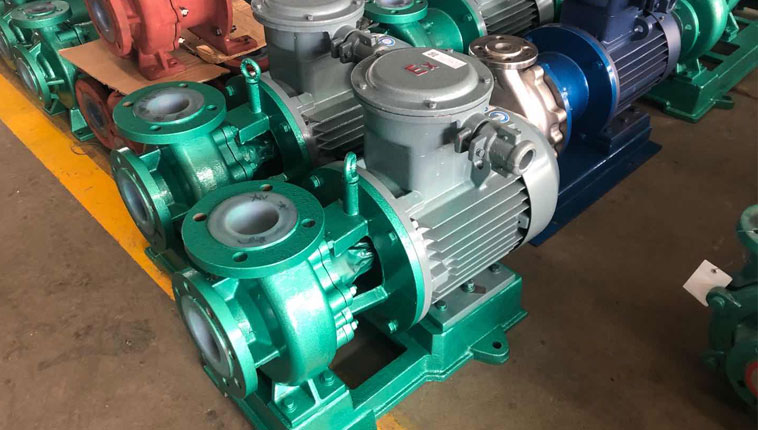Fluoroplastic centrifugal pumps are widely used in chemical, pharmaceutical, environmental protection and other fields due to their excellent corrosion resistance and high and low temperature resistance. However, in actual use, due to a lack of in-depth understanding of the equipment characteristics or improper operation, they often fall into various misunderstandings, which not only affect the normal operation efficiency of the equipment, but also may shorten the service life and even cause safety accidents. The following is a detailed analysis of the common misunderstandings in the use of fluoroplastic centrifugal pumps.
Misunderstandings in Pump Selection
There are many pitfalls in the selection of fluoroplastic centrifugal pumps. Some users simply determine the pump model based on the medium name, ignoring the specific parameters of the medium. This is a big misunderstanding. For example, the requirements for pumps for sulfuric acid and hydrochloric acid of different concentrations are very different even for acidic media. If key parameters such as medium concentration, temperature, and solid content are not clearly defined, the corrosion resistance of the selected pump may not meet actual needs, resulting in premature corrosion and damage to the pump body.
Some users also blindly pursue models with large flow and high head. They think that the larger the equipment parameters, the more reliable it will be, but in fact this will cause serious waste of energy. Moreover, when the pump is operated at a point that deviates from the design operating point, it is easy to have problems such as reduced efficiency and increased vibration, which in turn affects the stability and service life of the equipment.
In addition, ignoring the influence of impurities in the medium is also a common error in selection. The impeller and other components of the fluoroplastic centrifugal pump are more sensitive to impurities. If the medium contains a lot of particulate impurities and the appropriate filter device or wear-resistant model is not selected, it will accelerate the wear of the impeller and even cause the impeller to clog, affecting the normal operation of the pump.
Mistakes during installation
Improper operation during the installation process may also pose a hidden danger to the use of fluoroplastic centrifugal pumps. One of the common misunderstandings is unreasonable pipe connection. Some installers do not ensure that the pipes are concentric with the inlet and outlet flanges of the pump when connecting the pipes, resulting in obvious deviations. This will cause additional forces to be generated during the operation of the pump, resulting in increased vibration of the pump body, decreased sealing performance, and in severe cases, damage to the pump shaft.
The instability of the foundation installation should not be ignored either. Some users believe that fluoroplastic centrifugal pumps are light in weight and do not require strict foundation fixation, so they can be put into use after being simply placed. However, during the operation of the pump, especially under high speed conditions, it will produce large vibrations. If the foundation is not stable, the vibrations will continue to be transmitted, which will not only affect the operating accuracy of the pump, but may also affect surrounding equipment and shorten the service life of the pump.
In addition, ignoring the sealing of the suction pipe is also a major misunderstanding during installation. If there is a leak in the suction pipe, air will enter the pump, causing cavitation, which will manifest as a decrease in the pump's flow rate and head, an increase in operating noise, and in severe cases, damage to the impeller and pump body.
Misunderstandings in Operation
There are also many misunderstandings in the operation and use of fluoroplastic centrifugal pumps. One of the common mistakes is not to make sufficient preparations before starting. Some users do not check whether the pump is in the correct direction when starting the pump, nor do they open the inlet valve to fill and exhaust the pump, and start the pump directly, which can easily cause the pump to run dry. The impeller and pump body of the fluoroplastic centrifugal pump rely on liquid lubrication and cooling. Dry running will cause the temperature of the friction part to rise sharply, causing the fluoroplastic material to melt and damage, seriously affecting the service life of the pump.
It is also a big misunderstanding to ignore parameter monitoring during operation. Some users do not pay attention to changes in parameters such as the pump's outlet pressure, flow, vibration, and temperature during operation, and fail to detect abnormalities in the pump's operation in a timely manner. When the pump experiences problems such as a drop in flow or unstable pressure, if the pump is not stopped and inspected in time, small problems may develop into major failures and even cause safety accidents.
In addition, improper shutdown operation can also cause damage to the pump. Some users turn off the power directly when shutting down the pump without closing the outlet valve first, which will cause the liquid in the pipeline to flow back and produce a large impact on the pump impeller. If this continues for a long time, the impeller will become loose and damaged.
Misunderstandings in Maintenance
The maintenance of fluoroplastic centrifugal pumps is crucial for the long-term stable operation of the equipment, but there are also many misunderstandings in the actual maintenance process. Excessive replacement of wearing parts is one of the common mistakes. Some users believe that as long as it is a wearing part, it should be replaced regularly without considering its actual wear. This not only increases the maintenance cost of the equipment, but may also affect the performance of the pump due to improper replacement. In fact, the decision to replace the wearing parts should be based on the actual wear and operating conditions of the wearing parts.
Ignoring the cleaning and maintenance of the pump is also a major misunderstanding. If the fluoroplastic centrifugal pump is not cleaned in time after conveying impurities or viscous media, the media will be deposited and solidified in the pump, blocking the flow channel and affecting the pump flow and head. At the same time, the deposited media will also corrode the pump body and impeller, shortening the service life of the equipment.
In addition, improper maintenance of seals can also affect the operation of the pump. Some users do not select the appropriate model and material when replacing seals, or the compression of the seals is not appropriate during installation, resulting in leakage in the pump. Seal leakage not only causes medium waste, but also may cause safety and environmental problems.
Misunderstandings in Material Cognition
There are also some common misunderstandings about the materials of fluoroplastic centrifugal pumps. Many users believe that fluoroplastic materials are extremely corrosion-resistant and can adapt to all corrosive media. This is a wrong understanding. Although fluoroplastics have excellent corrosion resistance, different types of fluoroplastic materials also have differences in corrosion resistance. For example, polytetrafluoroethylene (PTFE), polyperfluoroethylene propylene (FEP), etc., have different corrosion resistance to different media. For some special highly corrosive media, such as fluorides at high temperatures, some fluoroplastic materials may not be able to withstand.
Some users also believe that the material of fluoroplastic centrifugal pumps is hard and not easy to damage, so they neglect the protection of the equipment during use. In fact, although fluoroplastic materials have a certain hardness, they are also brittle. When subjected to severe impact or rapid temperature changes, they are prone to cracking and damage.
In short, understanding these misunderstandings in the use of fluoroplastic centrifugal pumps and adopting correct use and maintenance methods are of great significance for improving the operating efficiency of equipment, extending its service life, and ensuring production safety. In actual application, we should strengthen the training of operators, establish a complete equipment management system, regularly inspect and maintain the equipment, so that the fluoroplastic centrifugal pump can better serve the production.





 +86 18130251359
+86 18130251359 teflowpumps@tlpumps.com
teflowpumps@tlpumps.com











 +86+0563-5093318
+86+0563-5093318
